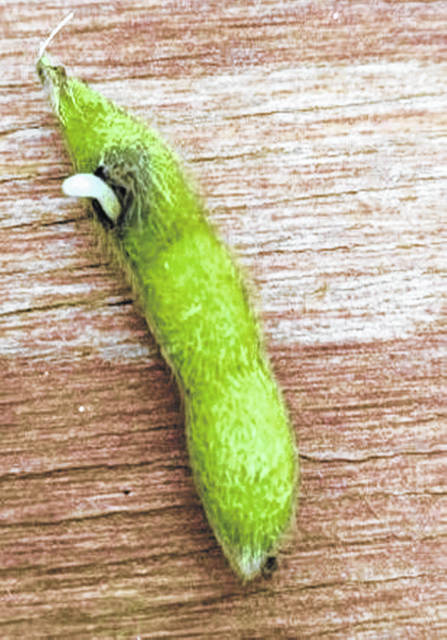

It was a hot week for the Farm Science Review this past week and the attendance was down, I think due to the extreme heat, as well as many producers harvesting or getting ready for this fall’s harvest.
The weather experts are saying the next rainfall system will move across the region later this weekend. Another system will move through by the middle or the end of next week.
Overall, they expect rain systems every 3-7 days until further notice. There will be dry periods mixed in as well so this will not be a continuous wet period by any means.
The wetter pattern may cause some delays in the fields over the next 30-60 days so it will be important to take advantage of those dry stretches.
The first freeze is nowhere to be seen. We expect a normal first freeze in the Oct. 10-20 range for most places.
Over the next two weeks, forecasts are predicting rainfall will average 1-3 inches with isolated 4+ inch rain events in some areas.
There were many good discussions and some were positive and others not-so positive as we heard from many producers expressing concerns due to late season disease, such as severe Frogeye, diaporthe stem cancer in soybeans, pod feeding, ear worm, corn sprouting, diplodia ear rot in corn and unfortunately the list goes.
One subject that I surprisingly heard more about than I would want to was the topic from around the state of green soybean pods splitting and also seed sprouting out of pods.
According to Laura Lindsey, Ohio State Soybean agronomist, while it is not uncommon to see pre-harvest pod shatter just prior to harvest due to re-wetting of dry pods, the pictures we’ve received have been of soybeans at the R6 growth stage.
Splitting of green pods may be related to the recent warm, wet (high intensity rainfall), and humid weather. (The Western Agricultural Research Station in Clark County had a high temperature of ≥93°F over a three day period in September followed by 3.5 inches of rain in a four day period.)
Wet conditions at the R6 growth stage results in a large seed size that may split pods. Once the soybean pod is open, the seed is susceptible to pre-harvest sprout (germination of seed in the pod prior to harvest). Researchers have found differences in pre-harvest sprout among soybean cultivars.
Another (potential) cause of pre-harvest sprout is insect feeding. Feeding may open the pod where moisture can enter and sprout the seed.
Finally, if you have not gotten your grain storage bins ready for storage now is the time.
Ohio State University Extension Educator Curtis Young, CCA says the first step to bin preparation for the upcoming storage is sanitation, sanitation, sanitation. Everything that comes into contact with the grain should be cleaned thoroughly to remove all old grains that could potentially be harboring insect infestations.
These items include, but are not limited to: grain carts, wagons and trucks, combines, combine heads, augers, grain dumps and pits, grain legs, grain driers, and bins (inside and outside).
Any spilled grain should be removed. Old seed and feed sacks should be disposed of. Any bin that is to be used for this upcoming harvest season should be empty.
Never place new grain on top of old grain.
He also suggests, if bin treatment is required, before using any product to treat grain bins, always read the most current label for the product to assure that the product is used correctly. This is for the protection of the grain to be stored in the bin as well as for the protection of the applicator of the product.
Labels for products are subject to change from one year to the next, product registrations can be changed and/or canceled and rates may be changed.
Errors made because of not reading the most current label could result in injury to the applicator or contamination of the grain with a non-labeled product making it unsalable.
Bins with perforated aeration floors (a.k.a. “false floors”): If a bin has had a known insect problem in the recent past where a residual population of the insect(s) could be hidden under the perforated aeration floor, fumigation might be the only option to destroy these hidden insects.
The most likely product to be used for this purpose is aluminum phosphide (phosphine gas) which is sold under a number of different trade names such as Phostoxin, Fumitoxin and Weevil-Cide. When determining the proper dosage for treating the empty bin, one has to remember that the dosage is based on the total volume of the area into which the fumigant is being released.
Remember! There are several precautions to be addressed when using aluminum phosphide as a fumigant.
Interior bin surface treatments: There are very few products left registered for use around and on stored grains. Thus, the list is short.
For corn and popcorn bins, products registered for interior surfaces of empty storage bins include:
• Tempo SC Ultra (a.i. is cyfluthrin) used as a liquid spray
• Centynal (a.i. is deltamethrin) used as a liquid spray
• Pyronyl (a.i. is pyrethrin) used as a liquid spray
• Diacon-D IGR (a.i. is s-methoprene) used as a dust application
• Insecto (a.i. is diatomaceous earth) used as a dust application
For soybean bins, products registered for interior surfaces of empty storage bins include:
• Tempo SC Ultra (a.i. is cyfluthrin) used as a liquid spray
• Diacon-D IGR (a.i. is s-methoprene) used as a dust application
• Insecto (a.i. is diatomaceous earth) used as a dust application
Always remember to practice in and around grain bin storage structures!
Tony Nye is the state coordinator for the Ohio State University Extension Small Farm Program and has been an OSU Extension Educator for agriculture and natural resources for over 30 years, currently serving Clinton County and the Miami Valley EERA.



